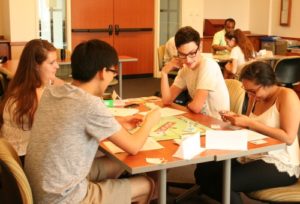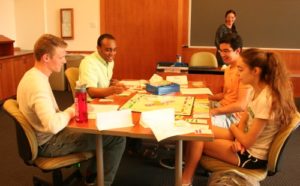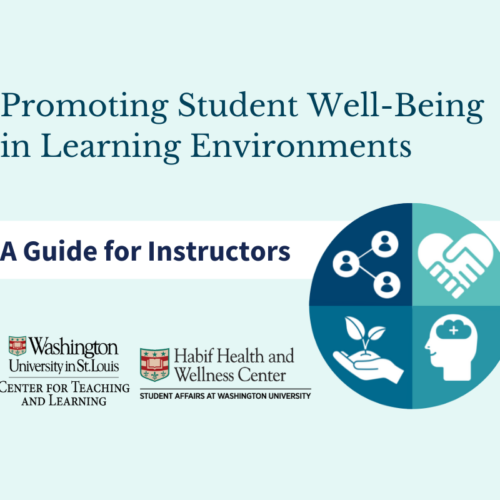“The Landlord’s Game” Teaches a New Generation About Inequality
As part of the Modern Segregation program initiative in American Culture Studies, Michelle Repice (lecturer in American Culture Studies and Assistant Director in The Teaching Center) teaches a popular course, “Home, Bittersweet Home,” which provides a multi-disciplinary lens on the history of home ownership in America. The course uses a case-study approach that is designed for students to touch down in critical moments in time to get a sense of the myths and realities of home ownership in America. Students explore a range of experiences including the “big house” and slave house of the 19th century American South, the early 20th century immigrant tenement and robber-baron mansions in New York, mid-20th century STL urban public housing and the post-war suburban boom, and the recent housing crisis in the 21st century.
As Repice led students through the decades, she found herself looking for ways to make tangible for students how history is a continuum—that is, how discriminatory realities don’t stop just because the official policies have changed. And so she was delighted to find a creative approach that fit her course perfectly: Monopoly as a learning tool. Developed by social psychologist Richard Harvey (who won a teaching award at St. Louis University in 2011 for this approach), “Intergroup Monopoly: A Lesson on the Enduring Effects of Inequality,” was designed with many of Repice’s objectives in mind: 1) to help students understand homeownership as both inclusionary and exclusionary, 2) to make visible and comprehensible the connections between unequal policies and practices and the unequal housing experiences and outcomes, and 3) to consider the longer term legacies of various forms of housing discrimination.
 A historian by training, Repice dug deeper into the origins of Monopoly, and found that it began not as mere entertainment, but as a pedagogical tool. Monopoly developed from “The Landlord’s Game,” which was created in the 1900s by a Quaker, Elizabeth Magie, as a teaching tool for learning about the social injustices of monopolies in particular and material inequality in general. (Repice found that, soon after its creation, the game was also adopted as a pedagogical tool in business schools to develop attitudes and strategies quite opposite to Magie’s intentions.) Harvey and Repice have returned to the roots of the game, using it to provide students with an experience of the powerlessness and losses of living within an unfair system.
A historian by training, Repice dug deeper into the origins of Monopoly, and found that it began not as mere entertainment, but as a pedagogical tool. Monopoly developed from “The Landlord’s Game,” which was created in the 1900s by a Quaker, Elizabeth Magie, as a teaching tool for learning about the social injustices of monopolies in particular and material inequality in general. (Repice found that, soon after its creation, the game was also adopted as a pedagogical tool in business schools to develop attitudes and strategies quite opposite to Magie’s intentions.) Harvey and Repice have returned to the roots of the game, using it to provide students with an experience of the powerlessness and losses of living within an unfair system.
Innovating upon Harvey’s approach, Repice refined the rules of the game to reflect the discriminatory practices and policies that the students had been learning about her course. For instance, she included “racially restrictive covenants,” that denied non-Whites access to certain neighborhoods, as well as “redlining,” which refers to how realtors and lenders mark certain neighborhoods in ways that impact housing prices and the availability and cost of loans in racially discriminating ways.
To show uneven wealth distribution, another rule has one of the players starting out with twice the money and property of everyone else. Others are restricted in buying only low-rent properties. While others—with no advantages or disadvantages—can play by regular Monopoly rules of chance and choice, buying what they can afford.
The groups of four play the game in this unequal way for 20 minutes, with results that range from the born-wealthy amassing property and money, some players landing in jail for extended periods, and one player never passing “Go.” After this inequitable beginning, Repice removes the crippling rules of redlining and restrictive covenants, as well as the advantages for the wealthy, changing to a “now everyone is equal” game for the final 40 minutes of class. Because the players continue from where they leave off, the removal of the oppressive rules does not help the outcomes equalize, especially for the marginalized team members. Many of them experience worsening conditions, including extreme indebtedness and bankruptcy.
Following the game, the students complete a reflective homework activity focused on their experiences, with questions that prompt students to make connections between their experiences and concepts from the course and to consider how long they think the game would need to be played to compensate for the initial inequalities.
 The next class is then devoted to a discussion of student experiences and insights from the game. Students talk about what it was like to play under the oppressive rules and how a shift to equal rules did not make up for the legacy of inequality. Students often remark on how powerful it was for them to see these “unwritten rules”—to know that the playing field was uneven as they were playing. The very rich were also affected, saying that “it felt bad” to bankrupt others and “winning doesn’t mean as much when you play by different rules;” the very poor reported that they kept hoping for property and sometimes just stayed in jail because “it was cheaper to be there” than to move around the board. For future iterations of the game, students contributed ideas for new rules that illustrate real-world oppression, such as allowing the wealthy players to fund gentrification projects or to promote subprime mortgages (the latter of which exacerbated the recent foreclosure crisis).
The next class is then devoted to a discussion of student experiences and insights from the game. Students talk about what it was like to play under the oppressive rules and how a shift to equal rules did not make up for the legacy of inequality. Students often remark on how powerful it was for them to see these “unwritten rules”—to know that the playing field was uneven as they were playing. The very rich were also affected, saying that “it felt bad” to bankrupt others and “winning doesn’t mean as much when you play by different rules;” the very poor reported that they kept hoping for property and sometimes just stayed in jail because “it was cheaper to be there” than to move around the board. For future iterations of the game, students contributed ideas for new rules that illustrate real-world oppression, such as allowing the wealthy players to fund gentrification projects or to promote subprime mortgages (the latter of which exacerbated the recent foreclosure crisis).
In terms of implementing a simulation like this, Repice suggests opening the class with a mini-lecture on the pedagogical use of Monopoly so that students are invested in the process and don’t see it as the same old game. She also suggests setting up the gameboards before class to maximize playing time and randomly assigning students by having them draw teams and roles as they come into class.
In reflecting on the impact of this game-based approach, Repice observes that the Monopoly activity “worked really well as a culminating experience, as I covered many themes across the semester, and as they played the game, you could see the students integrating key concepts. The other impact of the activity was the experiential component, in that the students had the chance to feel a personal connection to key ideas in the course; they had emotional responses to the material that they would not have had otherwise.”





